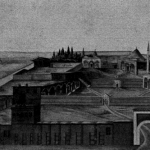Welcome to ‘Visual Hasluck: mapping Christianity and Islam in the Mediterranan’, a digital project of the Shared sacred sites network. Click on the images below to learn more and explore data.
[wcp-row ids=”6, 1, 7, 8″]Visual Hasluck is a digital humanities project undertaken as part of the “Shared sacred sites” research initiative, funded by the Henry Luce Foundation. It uses text analysis, mapping and visualization tools to revisit and analyze “Christianity and Islam under the Sultans” (1929), a milestone work by Enligh archaeologist Frederick W. HasluckFrederick William Hasluck (16 February 1878 – 22 February 1920) was an English antiquarian, historian, and archaeologist. Source: Wikipedia For more on Hasluck's life and work see Frederick and Margaret Hasluck.. “Christianity and Islam under the Sultans” is a diverse text largely based on Frederick W. Hasluck’s travels and field observations, from 1905 to 1915, compiled, edited and published in two volumes by his wife, Margaret HasluckMargaret Masson Hardie Hasluck: M.B.E. (1944) (18 June 1885 – 18 October 1948). She was a Scottish geographer, linguist, epigrapher, archaeologist and scholar. For more on Margaret Hasluck's life and work see Frederick and Margaret Hasluck. in 1929, nine years after his death. “Christianity and Islam” (you can access the text here) is a rich account of religious sites (churches and monasteries, mosques and tekkes Tekkes: dervish monasteries, religious communities (built complexes), religious complexes. Source: Getty Art & Architecture Thesaurus Online., caves and sacredTerm associated with religious and spiritual practices performed by one or different groups in a site or place. springs) that different ethnic groups and faith communitiesEthnic groups or faith-based communities performing religious, spiritual or secular practices in, around or in proximity to a site or place. have used over time or in which they meet, pray and interact with each other. What makes it rather unique is that, in contrast to similar works of the time that focus on bounded identities and classifications, Hasluck is more interested in mixing, interaction or what he calls “transferencesFrederick Hasluck uses “Transferences” as a term describing historical legacies and continuities from a certain culture or faith tradition to another through conversion, integration or transformation. Hasluck was deeply interested in “Transferences”, not only from Christianity to Islam but also from ‘paganism’ to Christianity. As his wife Margaret informs us: "he was preparing “two companion volumes on transferences from paganism to Christianity in the West and from Christianity to Islam in Syria and Palestine. Some of his work on transferences from paganism appears in his ‘ Letters on Religion and Folklore’". However, Hasluck himself was very aware of the challenges and limitations of trying to identify faith ’survivals’ or continuities: "Despite the readiness with...” between faith communitiesEthnic groups or faith-based communities performing religious, spiritual or secular practices in, around or in proximity to a site or place.. Instead of trying to trace clearly cut boundaries and categories he explores sacredTerm associated with religious and spiritual practices performed by one or different groups in a site or place. sites through a condition of mixing or ambiguity as his starting point.
Tekkes: dervish monasteries, religious communities (built complexes), religious complexes. Source: Getty Art & Architecture Thesaurus Online., caves and sacredTerm associated with religious and spiritual practices performed by one or different groups in a site or place. springs) that different ethnic groups and faith communitiesEthnic groups or faith-based communities performing religious, spiritual or secular practices in, around or in proximity to a site or place. have used over time or in which they meet, pray and interact with each other. What makes it rather unique is that, in contrast to similar works of the time that focus on bounded identities and classifications, Hasluck is more interested in mixing, interaction or what he calls “transferencesFrederick Hasluck uses “Transferences” as a term describing historical legacies and continuities from a certain culture or faith tradition to another through conversion, integration or transformation. Hasluck was deeply interested in “Transferences”, not only from Christianity to Islam but also from ‘paganism’ to Christianity. As his wife Margaret informs us: "he was preparing “two companion volumes on transferences from paganism to Christianity in the West and from Christianity to Islam in Syria and Palestine. Some of his work on transferences from paganism appears in his ‘ Letters on Religion and Folklore’". However, Hasluck himself was very aware of the challenges and limitations of trying to identify faith ’survivals’ or continuities: "Despite the readiness with...” between faith communitiesEthnic groups or faith-based communities performing religious, spiritual or secular practices in, around or in proximity to a site or place.. Instead of trying to trace clearly cut boundaries and categories he explores sacredTerm associated with religious and spiritual practices performed by one or different groups in a site or place. sites through a condition of mixing or ambiguity as his starting point.
“Visual Hasluck” aims to visualize this “ambiguity” by highlighting connections between different sites and placesNamed locations mentioned by F. W Hasluck in relation to religious sites, groups and practices, monuments or citing other sources., ethnic and religious groups, religious practicesSecular or religious uses of a site or place (e.g. ritual, pilgrimage), saints and holy figures as they appear in the text. Also, by mapping the sites and placesNamed locations mentioned by F. W Hasluck in relation to religious sites, groups and practices, monuments or citing other sources. mentioned, it renders a geography of the text as a means of exploring spatial relations, historical trajectories and contemporary realities.
In light of current crises in Europe and the Middle East and dominant discourses of religion- based conflict and division it is critical to return to this text with a new set of eyes. We hope that through a new, digitally enabled reading, “Christianity and Islam”, already a valuable resource for scholars working on religious interaction and the cultural history of the Balkans and the Eastern Mediterranean, will open up to new insights, narratives and audiences.

